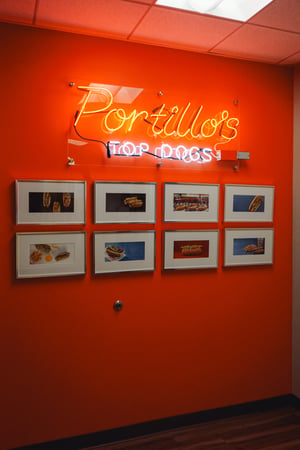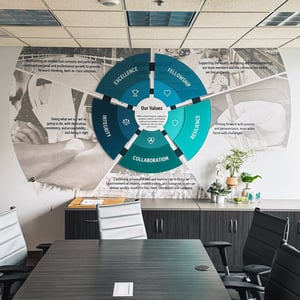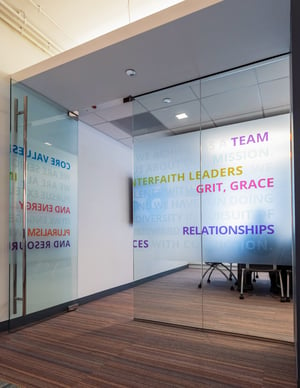Beyond Class A
Prestige once defined the modern office. The gleaming tower. The prime address. The promise of Class A amenities. But as workplace expectations evolve, the “Flight to Quality” tells only part of the story. Today’s most successful environments are measured less by square footage and more by how the workplace makes people feel — and whether it reflects a culture worth showing up for.
As the purpose of the office continues to evolve, experience has become the new differentiator.
In a corporate landscape shaped by Return to Office efforts, talent competition, and renewed focus on organizational culture, innovative companies are transforming their workplaces into immersive brand experiences. A custom, culture-driven workplace is emerging not as a perk, but as a strategic advantage — one that directly influences how businesses attract, engage, and retain the people who drive their success.
/APA_Office_Placemaking_web_opt-03.jpg?width=342&height=214&name=APA_Office_Placemaking_web_opt-03.jpg)

Why Traditional Offices Are Falling Short
If experience is now the new benchmark for workplace success, many organizations are still struggling to deliver it. The gap between what employees need and what offices provide has become a major obstacle in attracting and retaining top talent.
Across industries, the data tells a clear story.
76% of facilities managers expect to create more interactive and engaging office environments within the next three years — a sign that today’s open office layouts are missing the mark (FM Link, 2025). From the employee side, only 38% strongly agree that their workplace provides a great experience, according to Gensler's 2025 Workplace Survey. That gap represents a powerful opportunity, especially for smaller organizations looking to compete with larger employers.
This disconnect has tangible business consequences. Employees in workplaces that deliver a great experience are 3.6 times more likely to say their office helps attract and retain top talent — and more likely to feel inspired, valued, and aligned with company culture (Gensler, 2025). Meanwhile, the most compelling reason people return to the office isn’t the amenities or tech. It’s social connection, with 65% of employees citing morale and colleague relationships as their top motivation (CBRE, Generational Insights on Modern Workplaces).
Despite these insights, workplace performance is still by and large measured through tunnel-vision financial metrics: occupancy rates, rent per square foot, cost reduction. Until organizations redefine value in terms of experience and human impact, they’ll continue to underutilize one of their most powerful tools for talent strategy.
Space to Experience
The most successful companies are moving beyond standardized office layouts to deliver environments that make people want to come to work: spaces that foster collaboration, creativity, and belonging. In practice, that shift means designing for how people work, not just where they work.
These investments create emotional engagement. A thoughtfully designed environment becomes a physical expression of company culture, reinforcing purpose, building trust, and ultimately influencing whether people stay or leave. In this Return-to-Office moment, the workplace must earn every commute by delivering a sense of experience that employees can’t find elsewhere.

Culture-Driven Customization
If the “Flight to Experience” defines the new workplace era, then brand expression is its most critical design principle. A well-designed office isn’t simply beautiful or efficient: it’s authentic. It reflects how a company works, what it values, and how it wants people to feel. A polished Class A address might impress visitors, but it’s the visual storytelling inside the space that shapes how employees connect to the brand every day.
This is where customization becomes powerful. A truly effective workplace is designed from a company’s identity, values, and purpose, translated into tangible elements that people can see and feel. That translation happens through:
- Branded graphics and environmental storytelling that immerse employees and visitors in the company’s narrative.
- Dimensional signage and wayfinding that combine functionality with personality, guiding movement while reinforcing tone and voice.
- Materials, finishes, and textures that echo brand values (e.g. sustainability, innovation, craftsmanship) through their physical presence.
- Interactive or dynamic displays (rotating product walls, layered installations, or modular panels) that keep the space evolving and encourage engagement.
When executed thoughtfully, these elements turn the office into a living brand environment — one that communicates purpose before conversation. Walls become storytelling surfaces; meeting rooms become culture statements; lobbies become onboarding tools.
Ultimately, the workplace transforms from a place people go into a place they belong. It becomes an active participant in performance, reinforcing connection, sparking creativity, and signaling to top talent that this is a place where they can do their best work.
Designing the Future of Belonging
The fight for talent in 2025 isn’t fought in Class A properties alone; it’s fought in the built environment, in the moments people experience when they walk in the door.
By aligning the physical space with your organization’s culture, talent-strategy, and future-of-work model, corporate leaders can convert workspace into a powerful engine of talent acquisition, employee retention and organizational performance.
In this new era of experience, every wall, texture, and branded detail becomes a conversation with your employees. The question isn’t whether your office impresses. It’s whether it connects.






Connecting People and Brand at Scale.
As brand storytellers, we combine creative design, precision printing, and expert installation to transform walls, windows, and spaces into meaningful experiences.



/AtlasTube_Zekelman_Office-5.jpg?width=300&name=AtlasTube_Zekelman_Office-5.jpg)